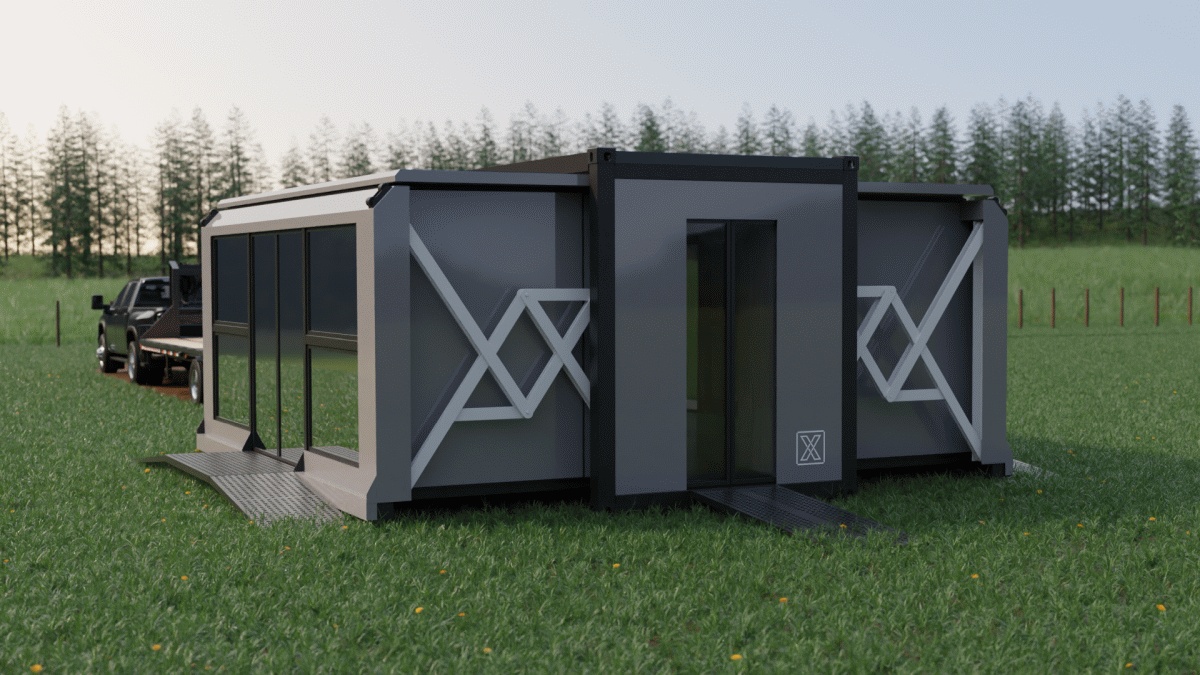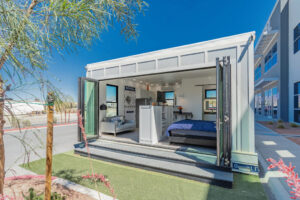Featured image: Tenfold Engineering’s TF-20 foldable house
Key Takeaways
- Foldable houses are innovative portable dwellings that can collapse for easy transport and expand on-site.
- The article reviews four unique designs: Boxabl Casita, Tenfold TF-20, Brette Haus cabins, and Madi Homes.
- Each design offers different folding mechanisms, sizes, and applications, from compact studios to larger customizable homes.
- Prices range from around $60,000 for basic models to over $300,000 for high-end designs.
- Foldable houses show potential for providing affordable, eco-friendly, and adaptable housing solutions in the future.
Foldable houses are an innovative category of portable dwellings engineered to collapse down in size for easy shipping and transport. Their foldable form factors maximize mobility without sacrificing livable space. Interest in foldable homes has surged recently as housing costs escalate and buyers increasingly value adaptability. Clever folding mechanisms allow the structures to expand on location to reveal fully-featured living spaces.
In this post, we review four of the most unique foldable house designs that exemplify the potential of this revolutionary new architectural approach. These models include the Boxabl Casita with its origami-style vertical folding walls, the Tenfold TF-20 and its hydraulic deployment system, Brette Haus’s cabins using patented hinges for repeated folding cycles, and Madi Homes’ modular sections that stack vertically when collapsed. By comparing the designs, capabilities, qualities, and ideal applications of each innovative model, we’ll uncover the wide range of options in the foldable house field and guide you in selecting the optimal solution for different needs. These pioneering companies point to an appealing future of right-sized, eco-friendly housing endowed with flexibility and mobility.
Table of Contents
Boxabl’s Casita
The Boxabl Casita is a versatile foldable house featuring an origami-inspired design that enables the walls to collapse vertically into a compact box shape. We previously published an in-depth review of the Casita’s unique features and performance. To summarize, this innovative modular home can fold down small enough to fit inside a standard shipping container for easy road, rail, or sea transport.
Once on site, the Casita can expand out in about a day to reveal a fully equipped 361-square-foot residence with an open floor plan. Standard amenities include a full kitchen, bathroom, washer/dryer, and efficient HVAC system. The Casita’s proprietary folding capability stems from the use of specialized materials like steel, composites, and EPS foam structured with integrated folds. This allows the entire unit to transform from a home to a rectangular box in minutes. Starting around $60,000, the Casita provides an affordable turnkey housing solution perfect for converting small urban spaces into livable dwellings with minimal labor.
Tenfold Engineering’s TF-20
The TF-20 from Tenfold Engineering is a relocatable foldable structure designed to fit inside a standard 20-foot ISO shipping container. It uses a hydraulic system to automatically deploy itself once positioned on site, expanding to reveal approximately 400 square feet of open and adaptable interior space with up to 9.5-foot ceilings. Tenfold Engineering markets the TF-20 as a customizable structure suitable for commercial, residential, and emergency response applications. When folded down, it compacts into a box under 9 feet tall for cost-efficient overland, maritime, or air transport between locations.
Tenfold Engineering manufactures these resilient modular structures in the USA. The company indicates that the TF-20 will be priced between approximately $275,000 to $300,000 when sales to the public commence, reflecting a focus on high-end users. With its unique automated folding capability and redeployability, the TF-20 aims to provide adaptable space on demand.
Brette Haus Foldable Cabins
Brette Haus offers compact foldable cabins featuring a patented hinge system that enables easy transport and relocation. Their wooden cabins can collapse horizontally using an innovative folding mechanism for convenience. Brette Haus reports their cabins can withstand over 100 repositions thanks to the durable proprietary hinge design. The company’s cabins range from 15m2 to 20m2 (160 – 215 sq ft) in size when fully deployed, with adjustable interior layouts. They utilize sustainable cross-laminated timber construction engineered for structural strength and insulation.
Estimated pricing starts around €56,200 (approx. $60,000) for a basic 15m2 cabin model. With rapid installation and an emphasis on eco-friendly materials, Brette Haus’s cleverly engineered folding cabins provide customizable and portable housing or retail/hospitality spaces. Their patented hinge system aims to make temporary structures highly transportable and relocatable.
Madi Homes Foldable Houses

Madi Homes offers a wide range of foldable housing models constructed from modular wooden sections. Their buildings utilize a patented folding technique that allows the modules to collapse inward and stack vertically for overland or container transport. This enables accelerated on-site assembly with dwellings ready in as little as 8 work days. Madi houses are customized by clients selecting from diverse roof styles and sizes ranging from 30m2 up to 104m2 (320 – 1,100 sq ft). They feature sustainable cross-laminated timber construction with high insulation and energy efficiency.
Madi’s estimated pricing spans €60,000 to €180,000 ($65,000 – $195,000) depending on the fully equipped configuration. Their innovative modular folding architecture aims to provide high-quality sustainable housing rapidly across locations that can also be adapted over time.
Comparative Analysis
While sharing the core attribute of foldable architecture, these four models showcase diverse proprietary designs and capabilities.
The Boxabl Casita stands out for its vertical origami-inspired collapsing mechanism activated manually on-site. This allows rapid conversion between a deployed home and a compact rectangular box. In contrast, the Tenfold TF-20 utilizes an automated hydraulic system to extend itself once positioned. Brette Haus cabins feature horizontal folding via their patented hinge system to reduce width for overland towing. Madi homes collapse and stack their modular sections vertically using their patented technique.
For portability, all four-fold to fit within standard 12 m ISO shipping containers for convenient global transport. The Casita condenses into the smallest volume under 10 m long for a tiny home experience under 400 sq ft. The Tenfold TF-20 offers a footprint of around 450 sq ft, while Brette Haus and Madi range from mini 15m2 cabins up to spacious 100m2+ designs.
Customizability varies across the models. The fixed Casita comes fully outfitted from Boxabl. Brette Haus offers configurable cabins but within a limited 15-20m2 footprint. Madi enables the greatest flexibility to tailor both module layouts and sizes up to 100+ m2. The TF-20 also touts adaptability given its open 400 sq ft interior.
Regarding quality, all utilize durable materials and precision engineering, with Brette Haus and Madi leveraging sustainable cross-laminated timber construction. However, Boxabl’s focus on consistency in factory production may confer an edge in fit and finish. Pricing spans a wide spectrum, from around $60k for the basic Casita up to $300k+ for the high-end TF-20.
Ideal applications match the strengths of each design. The inexpensive Casita suits affordable housing or studios. Brette Haus works well for hospitality pop-ups. Madi’s custom modular houses facilitate larger permanent residences. The TF-20 flexes well as a mobile office or commercial space. Ultimately the optimal choice depends on needs.
Recommendations
Based on their key attributes, certain models may be best suited for specific applications:
- The compact Boxabl Casita serves minimalist housing or temporary studios given its fixed layout under 400 sq ft and fast deployment.
- Brette Haus‘s folding cabins work well for hospitality pop-ups or retail spaces given their wood construction, small footprints, and high mobility.
- Madi’s modular customizability facilitates larger permanent family homes tailored to an owner’s needs and local building codes.
- The Tenfold TF-20 flexes well as an upscale mobile office or commercial space with its open floorplan and automated hydraulic deployment.
Prospective owners should thoroughly assess their needs, budgets, timelines, and locations when evaluating foldable homes. Temporary structures favor rapid deployability and road mobility like the Casita or Brette Haus. Permanent dwellings require greater customizability and compliance with local permits, better matched by Madi’s modular designs.
Conclusion
Innovative folding homes like the Boxabl Casita, Tenfold TF-20, Brette Haus cabins, and Madi houses offer transportable and customizable housing solutions. Their unique designs optimize mobility while rapidly deploying practical living spaces almost anywhere. Selecting the right model depends on needs – from compact studios to larger customizable homes and adaptable commercial spaces.
Going forward, foldable architecture holds compelling potential to provide high-quality, eco-friendly dwellings with built-in flexibility and mobility. The companies leading this novel segment demonstrate the tremendous promise of intelligent, forward-looking designs for portable and dynamic living. Foldable homes are unfolding a smarter and more sustainable future for housing.




